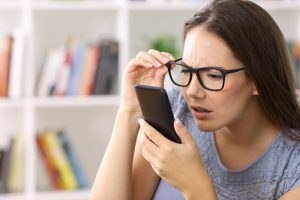
All this added screen time has led to an increase in digital eye strain, which leads to dry, irritated eyes, eye fatigue, eye strain, blurry vision, and headaches.
As more Americans are spending time staring at a screen, the risk of digital eye strain is on the rise and its affecting people of all age groups.
How to alleviate digital eye strain
We aren’t going to stop using our devices, so what can be done to reduce symptoms and protect our eyes? For starters, you should speak to your eye doctor about your screen time usage. A whopping 71 percent of Americans never discuss their screen time habits with their eye specialist, so they are left in the dark and are often unaware of the problem. Not talking to your doctor can put your eyes in harm’s way. There are things that can be done to protect your eyes, but if you don’t discuss it, then you will not know the options that are available to you.
For example, there is eyewear available to prevent eye strain. Even if you already have your own frames, there are specialty lenses that can be inserted into your favorite ones.
Another tip is following the 20-20-20 rule. This means for every 20 minutes of screen time, you look away for 20 seconds at something that is 20 feet away. You will also want to reduce overhead lighting to eliminate glare on your screen. Ensure that you are positioned arm’s length away from your screen and increase font size, especially on smaller devices, so you are not straining to read the text.
Lastly, and a more difficult tip, try to limit your screen exposure time if possible. It may be tricky, but you don’t need to look at a screen all day long. Taking moments away can help your eyes and lower your risk of digital eye strain.
Related: Asthenopia (eye strain): Causes, symptoms, and treatment